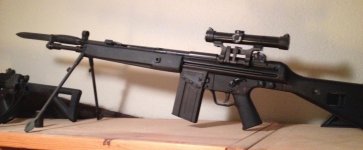There is some mis information and half truths in the thread so far that should probably be corrected or clarified.
The CETME came in a couple of flavors, the B and C that use different ammunition, but that requires some back ground.
The CETME was a Spanish parallel to the H&K G3 developed in collaboration with H&K after WWII and it was designed primarily by a German engineer who had developed the Stg 45 at the end of WWII. Collaboration with Spain was needed due to restrictions on small arms development in Germany following WWII.
The CETME and G3 differed as the G3 was designed to use the standard 7.62 NATO round, but the idea behind the CETME was to create an assault rifle with a truly intermediate cartridge - much like the Brits had intended with the L1A1 in .280 British or .280/30, before caving to pressure to adopt the 7.62mm NATO.
As such the 7.62mm CETME cartridge had the same exterior dimensions as the 7.62 NATO but fired a lighter (113 gr) plastic cored bullet at lower velocity (2600 fps). That was very close to the performance of the .280 British with it's 139 gr bullet at 2,545 fps and not much in excess of the 7.62x39 M43 round with a 123 gr bullet at 2425 fps or the original 7.92x33mm Kurz round with a 123 gr bullet at 2,250 fps.
The CETME Model B rifle was designed to use this less powerful round, while the later CETME Model C and E used the full power 7.62mm NATO standardized 147 gr round at about 2800 fps.
----
The H&Ks roller locked breech system is a delayed blowback operated system not a gas operated system. In very simple terms, the rollers delay the opening of the breech as the rifle recoils. To facilitate unlocking with some pressure still in the case, the chamber is also fluted to reduce the contact surface.
However the rollers and the recesses in the bolt have to be very precisely engineered and matched to the recoil impulse of the cartridge. This means that when Spain upgraded the CETME B to the CETME C model they had to change the roller lock system to match the more powerful M80 NATO ball round.
This means if you get a CETME, you have to know which model it is, and more importantly which rollers it has in it.
It also means that if you own a roller locked rifle designed for the M80 ball cartridge, like the H&K 91, G3, Springfield SAR-8, PTR-91 - or a CETME C - you have to shoot ammunition in it that is well matched to the roller system which is optimized for a 147 gr bullet at about 2800 fps.
----
The CETME, G3, H&K 91, SAR-8, etc all get a somewhat underserved reputation for being hard on brass when they are shot with ammo with heaver recoil impulse than the M80 ball load. This results in pre-mature unlocking of the bolt when the case is still adhered to the chamber wall and when pressure is still too high.
In the extreme, this results in the rifle throwing the brass about 50-70 feet and results in the flutes leaving very deep scoring on the case that makes it almost un-reloadable.
On the other hand, properly fed these rifles can be exceptionally accurate and very reliable. They just are not very amenable to variation in ammunition specifications.
That's the advantage the FAL had as it's adjustable gas system lets it shoot almost anything that comes in a .308 Win/7.62mm NATO case.
The FAL also however is a long and heavy rifle that handles like a m,such shorter and lighter rifle, where the G3, etc feels and handles heavier than it actually is, and it's actually pretty heavy already. Given a choice between a FAL and a G3, I'd choose to carry the G3 as well.
---
As for the CAI builds, I agree that their failure rate is high.
If you buy a CAI built CETME (or any other CAI built arm), be sure to buy it face to face where you can carefully inspect it inside and out, and buy from a local gun shop that will agree to refund your money if you find it won't shoot or function properly - with suitable M80 ball type ammunition.


